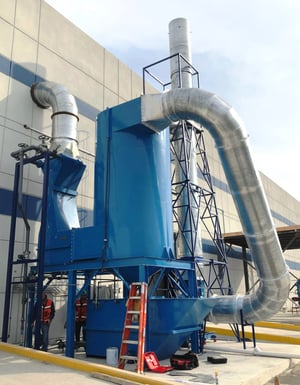If you have a problem with industrial air quality, then you need a dust collector. Finding the right one will depend on your air quality requirements and the particles that you’re dealing with.
While standard baghouses and dry dust collectors are great for a variety of applications, wet scrubbers – also known as wet dust collectors – are recommended when dealing with certain hard-to-manage pollutants, especially when you have a mix of particles and gases/vapors. Wet scrubbers are most effective at removing: 
- Soluble particles
- Fine particles and mists
- Wet or sticky particulate
- Mixes of particulate, vapors, and gases
- Combustible dust
How Does a Wet Scrubber Work?
While dry dust collectors rely on filter bags and cartridges, wet scrubbers use a scrubbing liquid to remove harmful contaminants from the air. Through the impingement process, wet scrubbers can remove both solid particulate and gases/vapors from an airstream, all in a single system.
You can modify a wet scrubber's efficiency and performance by manipulating the size of your scrubbing fluid's water droplets. The smaller the droplet, the higher your collection efficiency will be.
When designed correctly, wet scrubbers can achieve collection efficiencies of over 99%. In fact, Sly’s Venturi/Impinjet® combination scrubber can remove pollutants from stack emissions with a 99.999% efficiency rating.
When Should I Use a Wet Scrubber?
Wet scrubbers are suitable for a wide range of applications and industries, including food production, plastics, processing and machining, and healthcare devices/pharmaceuticals. No matter the industry, a wet scrubber may be right for your application if you have any of the following:
Soluble Particles
If your particles are easily dissolvable in water, then the scrubbing fluid of a wet scrubber may be the perfect means of particle removal. The scrubbing fluid will trap the dissolved particles for easy removal, creating a solution for recycling or disposal.
Fine Particles and Mists
The finer the particles, the more efficient a wet scrubber will be compared to a dry dust collector. Sly’s Venturi scrubbers are designed to collect smaller particles and mists using ultra-fine droplets to entrap contaminants and hold them in the solution.
Wet or Sticky Particulate
If your particulate is especially wet or sticky, it can easily clog a standard filter bag or cartridge. However, since you’re using a scrubbing fluid, wet or sticky particulate is no hassle for a wet scrubber.
Mixes of Particulate, Vapors and Gases
When dealing with a mix of particulate, vapors and gases, wet scrubbers are an efficient way to deal with multiple states of contaminants in a single dust collection system. We often recommend an Impinjet® wet scrubber when you need to collect particles 5 microns or larger with a variety of particulates, vapors and gases.
Combustible Dust
Depending on your application, dust explosions can be a major safety issue. The following are the necessary precursors to a dust explosion:
- Combustible fuel/dust
- Fuel/dust dispersion
- Potential ignition points (heat, friction, etc.)
- Free oxygen
- Confined spaces
That’s why, if you have combustible dust, then you need a dust collection system that’s made to mitigate the risk of an explosion. While there are many ways to help explosion-proof a baghouse, wet scrubbers effectively eliminate many of the precursors necessary to start an explosion.
The Sly Approach to Specifying a Wet Scrubber
Here at Sly, we’ve been helping the leaders of industry improve their air quality control for nearly 150 years. That experience has taught us how to specify the best dust collector for the task at hand. The perfect dust collector isn’t a standard “off the shelf” model, but rather one customized to your unique needs.
That’s why we work directly with you to understand your application and specific dust management needs before specifying a wet scrubber.
Here are some of the questions that we ask to learn more about your application:
- Do you have a particulate issue, a gas-phase issue, or both?
- How much dust is there? How much is coming to the scrubber?
- What’s the particle size distribution or average minimum particle size?
- What are the physical characteristics of the particles? Are they dry or sticky? Do they float or sink in water?
- Do you want to recover and recycle any captured dust?
Once we know more about your process, we can build off our past experience to design a wet scrubber system that’s tailored to your specific needs.
Venturi scrubbers are the go-to scrubber for a variety of higher-end scrubbing needs. Venturis can handle even the most demanding wet scrubbing applications, and with high collection efficiencies.
That said, Venturis are essentially the sledgehammers of wet scrubbers. They require more of a pressure drop to operate than other scrubbers, leading to higher energy costs for the consumer.
If you don’t have a lot of fine or sticky/stringy particulate, then one of Sly’s Impinjet® wet scrubbers is often the better option due to their lower energy costs. They may not have the power of a Venturi, but you don’t always need a sledgehammer to get the job done. If you have a dryer application, then the Impinjet® is likely the way to go.
Weighing your options and then finding the perfect solution is Sly’s specialty. Nobody knows dust collectors like us. We’ll make sure that you get the right tool for the job, that way you can maximize scrubber performance, efficiency, and product life for the best dust collection system possible.
Tags: wet scrubber




